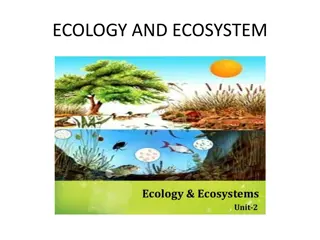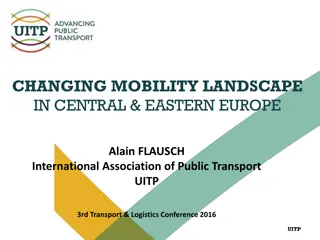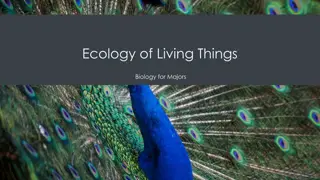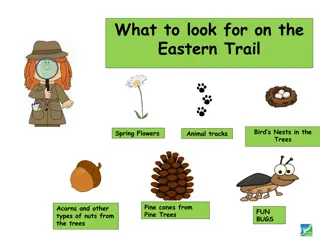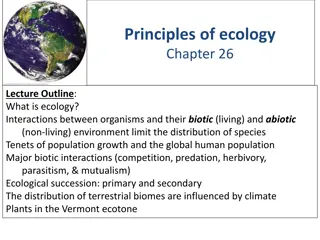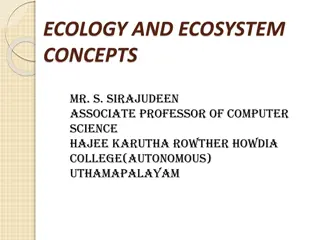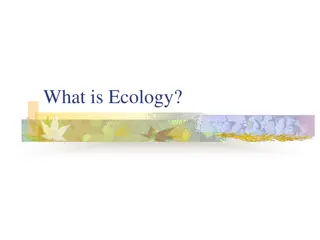Understanding the Ecology of Eastern Hellbenders
This comprehensive guide explores the ecology of Eastern Hellbenders (Cryptobranchus alleganiensis), discussing the abiotic and biotic factors influencing these fascinating salamanders. Covering topics such as populations, communities, and the essential role of producers, it sheds light on the challenges faced by hellbenders in their natural habitat.
Download Presentation

Please find below an Image/Link to download the presentation.
The content on the website is provided AS IS for your information and personal use only. It may not be sold, licensed, or shared on other websites without obtaining consent from the author. Download presentation by click this link. If you encounter any issues during the download, it is possible that the publisher has removed the file from their server.
E N D
Presentation Transcript
Hello, Hellbenders! The ecology of the Eastern Hellbender, Cryptobranchus alleganiensis
Hey Bill! Tell us about hellbenders!
Now lets use our new vocabulary to talk about these amazing creatures. Take some notes on your handout as we go!
ABIOTIC What does it mean? Non-living elements of an ecosystem How does it relate to hellbenders? What are some abiotic factors that affect these salamanders? Cover rocks Oxygen in the water How fast the water is moving (flow) Photo credit: Kent Mason, The Nature Conservancy Pollutants from human activity
BIOTIC What does it mean? Living elements of an ecosystem How does it relate to hellbenders? What are some biotic factors that affect these salamanders? Photo credit: Cathy Jachowski, Clemson University Other hellbenders (mating, competition for nest space and other resources) Prey (crayfish, other invertebrates) Predators (fish, turtles, etc. eat juveniles, raccoons and other mammals eat adults) Pathogens (parasites like nematodes, bacteria, etc.)
POPULATION Plethodon salamander species/populations What does it mean? A group of organisms of the same species living in the same place and interacting with each other How does it relate to hellbenders? Populations of hellbenders throughout Appalachia are facing multiple threats and are in decline Credit: Vincent Farallo
COMMUNITY What does it mean? All interacting biotic components of an ecosystem How does it relate to hellbenders? Hellbenders interact with other populations of organisms to make up the stream community (their prey, their predators, their competitors, even humans!) Credit: Javier S nchez-Hern ndez, Diversity, 2020.
PRODUCER What does it mean? Organisms that makes their own food using photosynthesis (plants, algae) How does it relate to hellbenders? Producers form the base of the hellbender s food chain (algae/plants crayfish hellbender ...) and help to oxygenate water Credit: Bryce L. Meyer
CONSUMER What does it mean? Organisms that eat other organisms (can t make their own food) How does it relate to hellbenders? Hellbenders are consumers! Credit: Instagram @branagan_hellbender
COMPETITION What does it mean? Two organisms need the same limited resource How does it relate to hellbenders? Hellbenders compete with other hellbenders (same species = intraspecific competition) and with other organisms (different species = interspecific competition) for resources in streams Photo credit: David Herasimtschuk What resources do hellbenders compete for?
PREDATION What does it mean? One organism feeding on another How does it relate to hellbenders? Hellbenders can be both predators and prey in stream ecosystems! Photo credit: David Herasimtschuk
LIMITING RESOURCE What does it mean? A factor that determines the size of a population of organisms How does it relate to hellbenders? Hellbender population size in a stream may be limited by the number of available nest sites or the amount of food available Photo credit: Jordy Groffen, Virginia Tech
CARRYING CAPACITY What does it mean? The maximum number of individuals in a population that can be supported by available resources How does it relate to hellbenders? Maximum population size of a hellbender population is determined by a variety of factors Photo credit: lumenlearning.com
BIOINDICATOR What does it mean? A species whose presence/absence can tell us about the overall health of an ecosystem How does it relate to hellbenders? Because hellbenders need very clean water, their presence indicates a healthy stream! They are bioindicators.
NICHE What does it mean? The range of conditions a species needs to survive, and the role it plays in the ecosystem How does it relate to hellbenders? A hellbender s niche includes its habitat (cool, fast-moving streams with high water quality) and what it does in the stream (its role as a predator, as prey for other species, etc.) Photo credit: Jordy Groffen, Virginia Tech
Now, use what youve learned! ON YOUR HANDOUT: Write a few sentences that describe the niche of the eastern hellbender. Use at least 5 words from the Word Wall!






